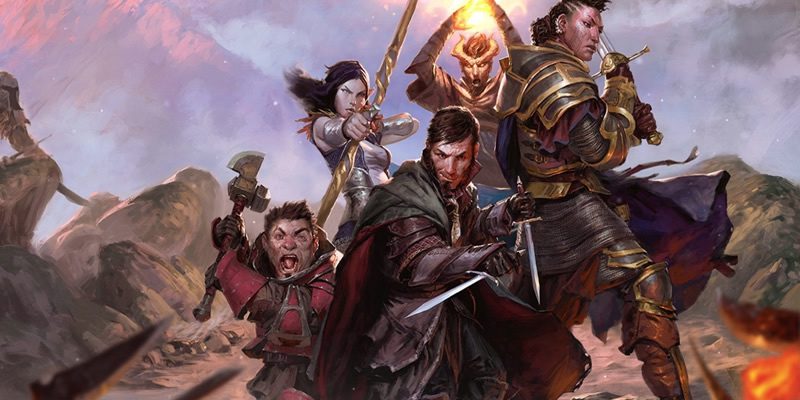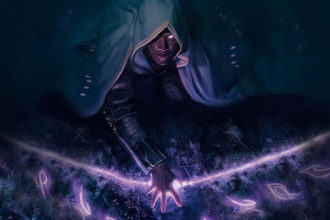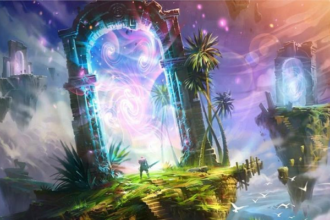UA 2020: Subclasses, Part 2B Breakdown

Déjà vu, all over again! There’s been a whole thing that is why this got retracted and reissued. You either know about it or don’t, you have opinions about it or don’t, but I’m not getting into it here.
College of Creation Bard
There was Eru, the One, who in Arda is called Ilúvatar; and he made first the Ainur, the Holy Ones, that were the offspring of his thought, and they were with him before aught else was made. And he spoke to them, propounding to them themes of music; and they sang before him, and he was glad. But for a long while they sang only each alone, or but few together, while the rest hearkened…
–“Ainulindalë,” The Silmarillion, by J.R.R. Tolkien
If you’ve been reading my column for any length of time, this quote should be no surprise. Here we have a bard that expounds the Song of Creation. As a result, it’s also blurring the lines between bard and cleric, in the vein of 4e’s invoker class – and I am so here for that. The flavor text also leans way into planar themes. What it does in the mechanics is another matter – let’s check that out.
- Note of Potential interfaces with Bardic Inspiration, as one would expect of a 3rd-level bard subclass feature. It creates a visible but invulnerable floating object that follows your Bardic Inspiration target around. When they spend Bardic Inspiration, your target also expends the object, in their choice of one of these three different ways.
- Note of Destruction is a splash of AoE damage equal to the result of the Bardic Inspiration die, for each adjacent creature that fails a Con save. The target has to expend the die for an attack roll to use it this way, and they’ve got to take some big positioning risks to use it efficiently, but that damage adds up.
- Note of Protection requires that the die be added to a saving throw, and grants some temporary hit points. These temporary hit points can’t be gained if you have any existing temporary hit points. That’s a little odd – normally “If you have temporary hit points and receive more of them, you decide whether to keep the ones you have or to gain the new ones.” I don’t really see what they’re getting out of closing that door, but there it is.
- Note of Inspiration has changed to Note of Ingenuity. The name was one of my main comments in the first draft, so good change there. Anyway, if you’re spending your die on an ability check, you can reroll the Bardic Inspiration die and use the better result. That changed from having to use the second result, addressing my other concern. I got everything I asked for here, so thumbs up.
- Animating Performance at 6th level turns a Large or smaller object into a dancing object – a combat pet, that requires your bonus action to do anything more than defend itself. It’s a pretty great use of your bonus action, though.
- It’s more destructible than a spiritual weapon, for a much longer duration, and deals respectable, if not superior, damage. It also moves faster. Spiritual weapon is a phenomenal spell from the moment you get it until you retire the character, so getting such a long-lasting cousin of it as a bard should be awesome.
- This switched places with Performance of Creation, had its damage toned down substantially, and now animates a pre-existing object rather than something you magicked up. On the other hand, this playstyle-defining feature shows up early enough to enjoy it for most of the campaign, so on the whole it’s a benefit to the bard.
- Performance of Creation at 14th level lets you create a fairly normal item from nothing (worth up to 20 gp per bard level), for a little while. Its duration is fairly involved – the longer you keep spending actions to maintain it, the longer it stays with you. The use frequency on this feature also does a new thing that subclasses have been doing that I really like – once per long rest, or you can reuse it by burning a spell slot of a given level (in this case, 5th). One object per customer (that is, at a time).
- This got retuned in several of the same ways as Animating Performance – doubling the potential value of the object you create, making it easier to extend its duration (1 minute of actions rather than 10 minutes), and a 5th-level slot to refresh it rather than a 3rd.
Two last, burning questions.
- Who is the Creation bard, Belle or the Beast? (Obviously the Genie is a Creation bard.)
- Can I create a teakettle, clock, or candelabra that sings to me and help me figure out my problems?
I think the revision has improved the gameplay of the class, though Performance of Creation as your “capstone” is probably not exciting enough. It’s awesome when you need it, but at 14th level, there aren’t many problems you can’t more easily solve some other way. Animating Performance fits into the narrative of the subclass now that you’re not animating something you created out of thin air, and there’s really no connection at all to the planar or reality-hopping ideas in the flavor text. More than the changes to the subclass, though, I think a few days of thinking about this has just left me less satisfied with it overall.
Unity Domain Cleric
As a general statement, I don’t love “unity” as a god’s domain or portfolio element, but I have written one of these in a setting that I care about. The faith is called the Redwood Throne, and they hold unity and truth as their guiding principles. Of course, they approached those ideas with staggering arrogance, so what they accomplished was massive divisiveness, built on a foundation of lies. Which is just what you’re asking for, narratively, if you approach your goals with arrogance.
Also I know the Nicene Creed and the definition of lower-case c “catholic.” That unity has not, historically, gone great for Christians. This has been a few words on “how does this probably go catastrophically awry?”
- Your Domain Spells are almost exclusively buffs, plus sending, guardian of faith, and Rary’s telepathic bond. Not having to spend preparation slots on these spells that you’re probably always going to want is always good.
- Emboldening Bond is bonds-of-camaraderie kind of love – it grants a “shared” bless effect, sort of, that can also add its d4 to ability scores. The targets only benefit from it once per turn, rather than every applicable roll, and they have to stay within 30 feet of each other – but it doesn’t cost concentration, and lasts for an hour. Once per long rest, or refresh by expending any spell slot. Well, this is hugely appealing.
- Channel Divinity: Shared Burden at 2nd level lets you redistribute incoming damage among any number of allies.
- In addition to the obvious tactical benefits and getting to redistribute damage over to allies who have resistance or immunity to that flavor of damage, it also guarantees the effectiveness of spells like prayer of healing, and lets you solve for characters who are running low on HD to spend for out-of-combat healing.
- Protective Bond at 6th level upgrades Emboldening Bond. One side of the bond can use their reaction to grant the other resistance to all damage. So it’s warding bond except the other side of the bond doesn’t take any damage.
- Potent Spellcasting 8th level does what Potent Spellcasting does. There’s a sidebar discussing who gets Potent Spellcasting versus who gets Divine Strike – it’s what you’d expect.
- Enduring Unity at 17th level is a capstone version of Emboldening Bond. The range limit on Emboldening Bond becomes “while on the same plane of existence.” Also, if one member of the bond goes to 0 hit points (regardless of whether they die), the other member gets a huge 1-minute boost: advantage on attack rolls, checks, and saves, resistance to all damage, and healing the partner by touch, by expending Hit Dice.
The Domain Spells and the Channel Divinity are the only meaningful changes. I would enjoy playing this if unity was a central question of the setting – a kingdom or republic sliding into a civil war, maybe.
Clockwork Soul Sorcerer
Everything has a purpose, clocks tell you the time, trains takes you to places. I’d imagine the whole world was one big machine. Machines never come with any extra parts, you know. They always come with the exact amount they need. So I figured if the entire world was one big machine… I couldn’t be an extra part. I had to be here for some reason.
–Hugo Cabret in Hugo
It says Clockwork Soul and means “what if your sorcery came from Mechanus?” Since I’m 100% here for maybe some sort of Great Modron March (Primus sucks), well, you can guess that I’m excited to find out what makes this sorcerous origin… tick.
Maybe like five people got every part of that very dumb Primus joke, but I’m sticking with it.
- Manifestations of Mechanus is a d6 table of quirks attached to your spellcasting. The more sorcerous origins get this kind of quirk, the more I like them.
- Clockwork Magic is a new feature in the revision. You gain a total of 10 new spells known, two at each of the first five spell levels. Ten spells known is a big deal for any sorcerer, though it’s something we also saw in the UA Aberrant Mind sorcerous origin a few months ago.
- Because of the temporal implications of clockwork, I confess that I am surprised haste and slow aren’t on this list. That said – once Mechanus is your theme, that’s plenty cool enough to commit to 100%.
- TIP: Do your Draconic and Wild Magic sorcerers a solid and houserule maybe 5 extra spells known, one at each level up to 5th.
- Restore Balance lets you negate advantage or disadvantage on a creature within 60 feet. It costs your reaction, and you can do it Cha modifier times per long rest.
- Okay, as with anything where you spend a resource to negate dis/advantage at the time of the roll, you’re going to have a lot of times when you look at the roll and have no idea if your reaction changed anything. Sure, if there are additional “when you have advantage” effects, as with Sneak Attack or the Samurai subclass, it’ll be much clearer that you’ve Done Something. Without that… the roll succeeds or fails, but maybe that was going to happen anyway?
- Bulwark of Law at 6th level lets you convert sorcery points into damage mitigation for yourself or another creature, at 1d8 per point, up to 5 at a time. You can only maintain one Bulwark at a time, but still – there are very few “mana shield” effects in D&D, and it’s fascinating to see one here.
- Leader vibes off a sorcerer? Don’t see that every day. I like it.
- I’m surprised, but not displeased, to see this go from d6s to d8s.
- Trance of Order at 14th level a self buff that takes an bonus action to activate (that’s kind of surprising by itself – we’re seeing a lot of this kind of self-target super-mode stuff go to bonus actions these days), and lasts for a minute. During that time all of your natural rolls of 9 or lower count as natural 10s, and no advantage that is formed against you shall prosper. Once per long rest, or burn 5 sorcery points to do it again.
- Note the change from action to bonus action.
- Clockwork Cavalcade at 18th level summons a host of modrons (they’re not marching, it’s not time yet) – well, spirits that look and act like modrons – that heal creatures of your choice out of a pool of 100 hit points, repair what’s broken, and end all spell effects of 6th level and lower in the 30-foot-cube effect area. It costs your action to use, which feels about right, and you can use it once per long rest, or spend 7 sorcery points to use it again.
- This got retuned to be more useful and more expensive – it heals a very respectable amount of damage now rather than just stabilizing the dying, it ends spells of 6th rather than 5th, and it costs two more sorcery points to reuse than in the first version. That extra throughput does help it feel like the badass 18th-level feature it should be.
This subclass got a wide variety of minor to moderate boosts. I figured it was probably okay before, because math-fixing from Trance of Order probably has some exploitative uses that I haven’t gone looking for. It’s still got that Planescape: Torment feel that I love to see, and I still think that its sorcery point costs make for a currency crunch, but I think what it has picked up is all fine.
Conclusion
My opinion has, as I said, cooled on the Creation bard. I still love the concept so much, but I feel like the flavor text and mechanics don’t have enough to do with each other.
The Unity domain looks fine. I have a hard time getting excited to play it, but that may change over time. The concept is kind of milquetoast, that’s all.
Clockwork Soul is my new favorite of these three. As WotC releases more subclasses with purely aesthetic suggestions, I’m warming up to them. My gaming community doesn’t usually go deep on players describing the visuals of their spells, or DMs doing it for them, but I can see wanting to use these at least the first couple of times you cast a spell each session.



